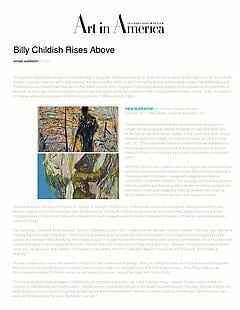
Art in America
January 3, 2012
Billy Childish Rises Above
By Aimee Walleston
"It's perfectly fine to wake up and find yourself lying in the gutter. But then you've got to work out how to stand up and step out of it," says prolific painter, musician, poet and writer Billy Childish. Known since the 1980s as the frontman for British punk and folk groups Thee Milkshakes and Thee Headcoats, Childish has often turned the darker corners of his biography to articulate various aspects of his tumultuous life and times. In previous oil paintings, Childish employed garish hues and violent gestures to depict himself, unhappy and inebriated (Drunk, 1996), or engaged in foreplay with a doppelganger of deKooning's Woman 1 (Billy and Dolli, 1996).
"I've been interested in trauma and dysfunction not as a place to inhabit, but as a place to liberate myself from," says the artist, who A.i.A. met at Lehmann Maupin gallery in the Lower East Side, where Matthew Higgs has curated his most recent show [on view through Jan. 21]. "The problem we have as humans is that we're addicted to believing we're not alive unless we're experiencing drama. But you really don't need to encourage trauma and dysfunction if you haven't got it."??
With that, Childish has created a series of large-scale oil-and-charcoal paintings that show a more refined, upbeat and considered approach. The works swirl in cerulean, orange and magenta and have an unaffected, out-of-time character. The paintings combine a fascination with the physical act of painting with a reverie for simple and beautiful portraiture, invoking an imaginary meeting between Van Gogh (a strong influence on Childish, he says) and Toulouse-Lautrec.??
Sibelius Amongst Saplings (2011) and Lt. Sydney A. Cloman, First Infantry, on His Horse on the Wounded Knee Battleground (2010) both feature imagery (of Finnish composer Jean Sibelius and Lt. Sydney A. Cloman on his horse at Wounded Knee, respectively) that address historical tropes of masculinity, duty and achievement. Each image shows its subject in darkened silhouette, outlined by vast landscapes in hyperbolic tones. ??
Two paintings, Toni Kurz Ascending and Toni Kurz Descending (both 2011), feature famed German mountain climber Toni Kurz, who died while climbing the North face of the Eiger. The former is a detailed close-up study (Childish derives most of his imagery from photographs) of the climber at a vertical incline, framed by the mountains face. The latter shows the climber in silhouette, scaling down the side of the mountain with a deep blue sky and white clouds behind him. "They show a man on his own out there doing this thing," he says. "I suppose it shows a certain verve and vim and vigor that I admire. But it's also a man on the end of his rope-it's a fragility; a humanity and a bravery. And maybe a stupidity."??
A small upstairs room has a retrospective Childish's printed matter and recordings. Many of Childish's books and records feature self-portraits that date from the artist's childhood onward. One winsome image from the back cover of a 1982 book of poetry, Prity Thing, features an impossibly cute Tracey Emin and Billy Childish mugging for the camera in their Sunday best (the two were once romantically involved, and so Emin naturally included Childish's named on her famous Everyone I Have Ever Slept With 1963–1995).
The louche aesthetic that permeates Childish's music, paintings and poetry, can make it appear "easy." Indeed, Childish seems intent on tempering craftsmanship with improvisation. "People always complained that our music wasn't polished enough," he says. "But we made a very clear decision to not re-record things that we felt had life and essence in them. With music or with painting, the more you get out of your own way and let the work be the work, the better it can get."
